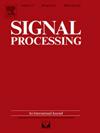Super Fourier analysis: A highly efficient framework for multivariate signal processing
IF 3.4
2区 工程技术
Q2 ENGINEERING, ELECTRICAL & ELECTRONIC
引用次数: 0
Abstract
The escalating integration of multi-sensor systems across diverse high-dimensional monitoring areas generates a large amount of large-scale multivariate signals. However, the theoretical foundation of efficient multivariate signal processing methods is currently lacking, making it challenging to fully exploit the value of multivariate signals under the requirement of rapid response. Here, we introduce super Fourier analysis (SFA), which innovates traditional Fourier analysis with the principle of multivariate statistics for highly efficient processing of multivariate signals. By integrating multi-channel information and reducing the data dimensionality, SFA can inherently handle the correlation across channels and has low time complexity. In the framework of SFA, we deduce and define the super Fourier series, super Fourier transform, and discrete super Fourier transform. Mode alignment property and noise resilience property of the SFA are analyzed. As an example, variational mode decomposition, a classic univariate signal processing method, is extended to multivariate context based on SFA. Our demonstrations include simulated signals, multi-channel electroencephalography, global sea surface temperature, and motion microscopy, highlighting SFA’s potential in rapid and large-scale multivariate signal processing. SFA’s efficiency and effectiveness promise its applications in various areas with a large number of sensors or channels, making the processing of multivariate signals as simple as univariate signals.
求助全文
约1分钟内获得全文
求助全文
来源期刊

Signal Processing
工程技术-工程:电子与电气
CiteScore
9.20
自引率
9.10%
发文量
309
审稿时长
41 days
期刊介绍:
Signal Processing incorporates all aspects of the theory and practice of signal processing. It features original research work, tutorial and review articles, and accounts of practical developments. It is intended for a rapid dissemination of knowledge and experience to engineers and scientists working in the research, development or practical application of signal processing.
Subject areas covered by the journal include: Signal Theory; Stochastic Processes; Detection and Estimation; Spectral Analysis; Filtering; Signal Processing Systems; Software Developments; Image Processing; Pattern Recognition; Optical Signal Processing; Digital Signal Processing; Multi-dimensional Signal Processing; Communication Signal Processing; Biomedical Signal Processing; Geophysical and Astrophysical Signal Processing; Earth Resources Signal Processing; Acoustic and Vibration Signal Processing; Data Processing; Remote Sensing; Signal Processing Technology; Radar Signal Processing; Sonar Signal Processing; Industrial Applications; New Applications.
 求助内容:
求助内容: 应助结果提醒方式:
应助结果提醒方式:


